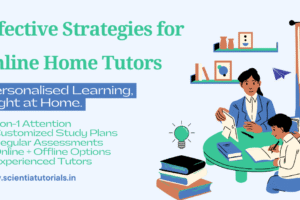Balancing Academics and Creativity: Essential Teaching Tips for Home Tutors
Introduction
Home tutoring provides an excellent opportunity for personalized learning, enabling tutors to tailor education according to the student’s individual needs. However, one of the most common challenges home tutors face is striking the right balance between academic subjects like math, science, and history, and creative subjects such as art, music, and drama. Both types of learning are crucial for holistic development. Academics build foundational knowledge, while creative subjects foster critical thinking, problem-solving, and emotional intelligence.
Balancing these two aspects is essential for nurturing well-rounded individuals. This article explores effective strategies and teaching tips for home tutors on how to harmonize academic rigor with creative freedom, ensuring that both areas are given equal importance in the tutoring process.
1. Understanding the Importance of Both Academic and Creative Subjects
Why Both Are Essential for Holistic Growth
Academic subjects are often prioritized because they form the core of standardized education systems. Math and science sharpen logical thinking and problem-solving skills, while subjects like history and language arts foster analytical abilities and comprehension.
Creative subjects, on the other hand, help students express themselves and explore new ideas in innovative ways. Art, music, drama, and creative writing are instrumental in building emotional intelligence, improving mental well-being, and fostering imagination.
As a home tutor, it’s essential to understand that both academic and creative subjects are interrelated. A well-rounded education incorporates both, contributing to intellectual, emotional, and social growth.
2. Assessing the Student’s Strengths and Interests
Personalizing the Balance Based on the Student’s Needs
Before deciding how much time to dedicate to academic and creative subjects, assess the student’s interests and strengths. Some students might naturally excel in creative subjects and struggle with academic topics, while others may be more inclined towards analytical subjects and feel less confident creatively.
By understanding these tendencies, tutors can design a customized learning plan that maintains a balance, while focusing on the student’s individual needs. For instance, if a student shows a particular interest in art, you can use their creative talent to enhance their understanding of academic subjects. For example, drawing diagrams in science or creating artistic representations of historical events.
At the same time, if a student is strong in math or science but less interested in creative pursuits, encouraging small doses of creativity throughout the week can help nurture a more well-rounded skill set.
3. Creating a Flexible Schedule
Incorporating Both Subjects Without Overwhelming the Student
One of the key challenges in balancing academic and creative subjects is managing time effectively. Creating a flexible schedule that allows for both structured academic learning and unstructured creative exploration is vital.
Start by designing a daily or weekly timetable that allocates sufficient time for academic subjects, while also ensuring that there is space for creative activities. For example, a typical schedule might include focused academic work in the morning, followed by creative sessions in the afternoon. Allow for flexibility, so students don’t feel pressured. This structure helps in preventing burnout from intensive academic sessions while keeping the creative spark alive.
A good rule of thumb is to alternate between academic tasks and creative ones to maintain energy and engagement. Incorporating short breaks between subjects also enhances productivity and allows for mental rejuvenation.
4. Integrating Creativity into Academic Subjects
Enhancing Learning with Creative Approaches
One of the most effective ways to balance academic and creative subjects is to merge them. By integrating creativity into academic learning, tutors can make subjects more engaging and interactive.
For example:
- Math: Use art to explore geometric shapes, patterns, and symmetry. Allow students to draw or paint mathematical concepts like fractions or percentages.
- Science: Encourage students to build models of scientific concepts or use creative writing to explain the life cycle of animals or the workings of the solar system.
- History: Bring history to life through creative reenactments, storytelling, or drawing timelines.
These methods help students connect with academic subjects on a deeper level, enhancing both their understanding and retention. Creative integration not only makes learning fun but also allows students to view academic subjects from different perspectives, fostering a deeper connection between the two.
5. Balancing Structured and Unstructured Learning
Combining Discipline with Freedom
Structured learning is crucial for developing discipline and ensuring progress in academic areas. However, too much structure can stifle creativity. Unstructured time, on the other hand, allows for self-expression and innovation, giving students the freedom to explore creative ideas at their own pace.
As a home tutor, it’s important to strike the right balance between structured academic lessons and unstructured creative activities. For example, you can set specific learning goals for academic subjects but leave creative tasks open-ended, allowing students to choose how they want to express their creativity.
Encourage them to explore different art forms, such as painting, drawing, music, or dance, without imposing strict rules. This will help them develop a sense of autonomy and confidence, which can positively impact their approach to both academic and creative pursuits.
6. Incorporating Multi-Sensory Learning Techniques
Engaging Different Learning Modalities
Multi-sensory learning combines visual, auditory, and kinesthetic teaching methods to stimulate different parts of the brain, making learning more effective. For example, academic subjects can benefit from visual aids, hands-on activities, or storytelling, while creative subjects can incorporate logical thinking and structure.
When teaching math, allow students to physically manipulate objects to understand concepts like volume, weight, or spatial relationships. Similarly, when teaching a creative subject like music, explain the mathematical patterns in rhythm and melody.
These multi-sensory approaches allow students to engage with subjects on a deeper level, making it easier to transition between academic and creative disciplines while reinforcing the connection between the two.
7. Setting Clear Goals and Expectations
Defining Achievable Milestones for Both Subjects
It’s important to set clear goals and expectations for both academic and creative subjects. Define what success looks like for each subject, and help the student achieve a sense of progress in both areas.
For academic subjects, these goals might include mastering specific concepts, achieving certain grades, or completing exams. In creative subjects, the goals might be more process-oriented, such as completing a project, exploring a new medium, or expressing a personal idea through art or music.
Be sure to celebrate achievements in both areas equally. Encouraging students to take pride in their academic and creative accomplishments helps build their confidence and fosters a balanced approach to learning.
8. Promoting a Growth Mindset
Encouraging Students to Embrace Both Academic and Creative Challenges
A growth mindset, which emphasizes effort and perseverance over innate talent, is essential for students to thrive in both academic and creative subjects. Tutors should encourage students to embrace challenges, view mistakes as learning opportunities, and understand that improvement comes with practice.
For instance, if a student is struggling with a math problem, frame it as a challenge that can be solved with effort and persistence. Similarly, if a creative project doesn’t turn out as expected, emphasize that the process of learning and experimenting is just as important as the final result.
By fostering a growth mindset, home tutors can help students become more resilient and confident in their abilities, whether they are tackling academic tasks or expressing their creativity.
9. Encouraging Self-Reflection
Helping Students Develop Self-Awareness in Learning
Encouraging students to reflect on their learning experiences in both academic and creative subjects is an effective way to promote balance. At the end of each week, ask students to evaluate what they’ve learned, what they enjoyed, and what they found challenging.
This reflection process helps students become more self-aware and enables tutors to adjust their teaching methods based on the student’s feedback. It also encourages students to take ownership of their learning, fostering independence and self-motivation.
10. Adapting to the Student’s Progress
Adjusting the Balance as the Student Grows
As students grow, their needs and interests may change. Tutors must be flexible and willing to adjust the balance between academic and creative subjects based on the student’s progress. If a student starts showing more interest or strength in creative subjects, consider allowing more time for exploration in that area while ensuring that academic subjects are not neglected.
Likewise, if a student needs extra help with academic topics, you can temporarily shift focus to reinforce those areas while still encouraging creativity through smaller, manageable tasks. Flexibility is key in maintaining a balance that supports the student’s overall growth and development.
Conclusion
Balancing academic and creative subjects in home tutoring is essential for nurturing well-rounded, confident learners. By understanding the importance of both areas, creating flexible schedules, integrating creativity into academic lessons, and promoting a growth mindset, tutors can provide a comprehensive education that meets the student’s intellectual and emotional needs.
Incorporating both structure and freedom, tutors can create a harmonious learning environment that encourages academic excellence while fostering creativity and self-expression. With careful planning, personalized instruction, and adaptive teaching methods, home tutors can help their students thrive in both academic and creative pursuits, preparing them for success in all aspects of life.



